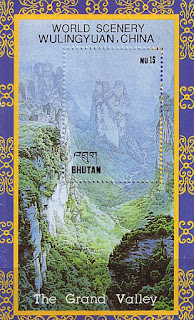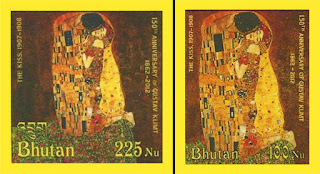As I mentioned in my yesterday’s post, while the country was still relatively an unknown entity, it appears that our postage stamps attracted a number of fakers and counterfeiters. In a way it should be a matter of pride that so many fakes and counterfeit stamps of Bhutan were produced. It goes to prove that our stamps are popular and sought after by the global collectors. On the downside though, it must be bad business for Bhutan Post who would be losing a substantial market share to spuriously produced stamps.
The following are some of the fakes/counterfeits:
WORLD SCENERY WULINGYUAN, CHINA
A fake intended for the world stamp collectors.
150th ANNIVERSARY OF GUSTAV KLIMT’s “THE KISS”
These stamps were total fakes. No one knows who created these. They were auctioned to unsuspecting collectors around the world. Like our original silk series of stamps depicting Thangkas, these fakes too were printed on silk.
AFRICAN ANIMAL SERIES
Another fake targeted at the collectors – Bhutan Post never issued these stamps. As is evident, this was a poor job – notice that the alphabet “u” after “N” in Nu. is missing.
JESUS SERIES
Yet another fake – this time with Christian overtones. Beautifully printed though – but fakes will always remain fakes, regardless.
One long time collector of Bhutanese stamps opined that this could have been the work of a Christian zealot – as retaliation for barring him/her entry into Bhutan. My own view is that the faked stamps may have been produced to raise funding for the conversion of Bhutanese into the Christian faith. You may recall that some years back there were rampant conversions in the remote villages of Bhutan – so much so that the government had to intervene by bring out a law that prohibited conversion from one religion to another. It is clear that the same people who faked the African Animal series were responsible for this thuggery as well – given that these fakes also has “u” missing after the alphabet “N” in Nu.
The following 1999 Goldfish Set is an example of poorly executed fakes. While the stamp was touted as being Bhutanese – the value of the stamp is denominated in Laotian currency.
In conclusion, I have to emphasize that we should be clear on what is a fake and what is a counterfeit. A very authoritative collector and historian went to great length to explain to me the difference between the two. He clarified that “fake” is when someone invents and entirely new design and content – totally unrelated to anything the Bhutan Posts had released.
Counterfeit on the other hand is something that a faker had attempted to reproduce an original item issued by the Bhutan Posts. In other words it is a copy.








No comments:
Post a Comment